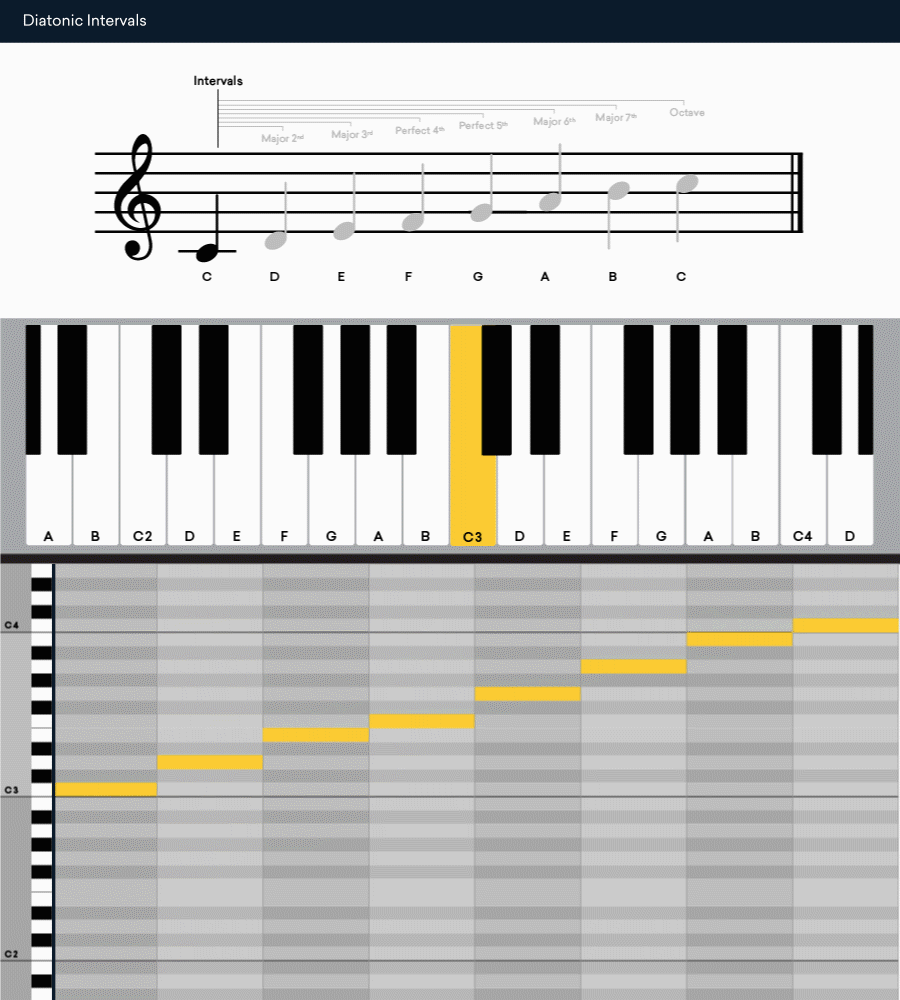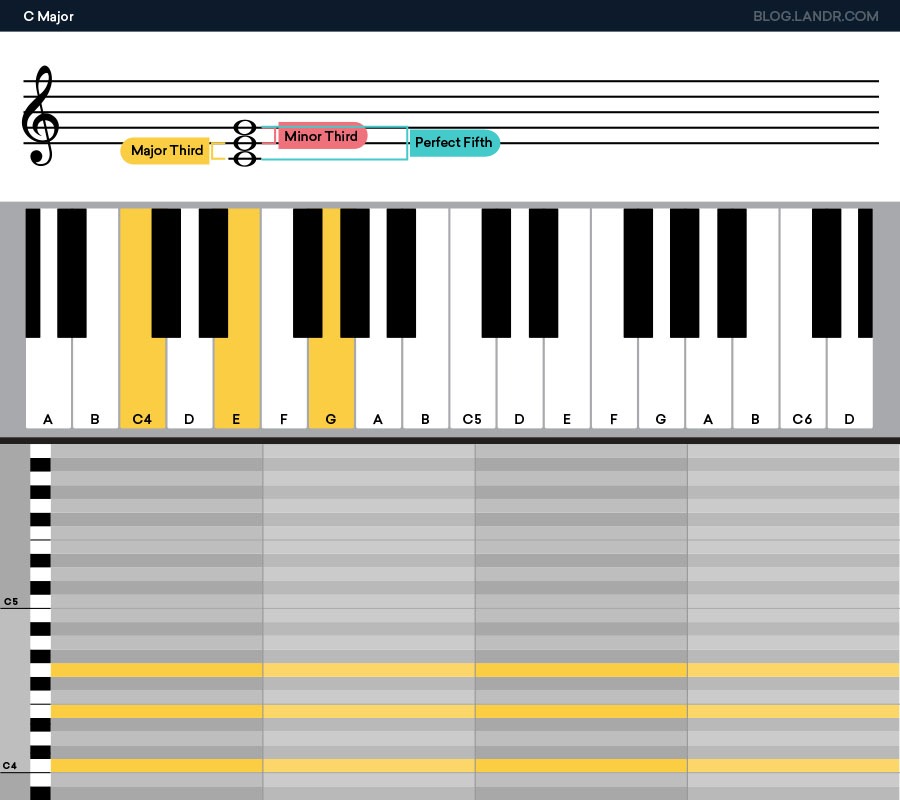
Music Intervals: How Notes Work Together

Music intervals are an essential part of every musician’s journey with music theory.
They’re the basic building blocks that make it possible to assemble chords, map out progressions and construct melodies.
But intervals can be difficult if you haven’t seen them before. With such a fundamental topic, it can be confusing just to get started.
Even so, the benefits are worth it. Knowing what intervals are, how to identify them and how to recognize them by ear will give you the tools you need to progress with music theory.
In this article, I’ll explain what intervals are, how to learn them and what they can do for your music.
Let’s get started.
Theory guides, production tips, new free plugins, gear guides and more—delivered weekly
Keep up with the LANDR Blog.
What are intervals in music?
Intervals in music are the distance between two musical notes. An interval can be between two notes that sound at the same time like in a chord, or between two notes next to each other like in a melody. Intervals can be any distance apart in frequency, but in western music they are almost always between notes of the diatonic scale.
If that sounds complicated, all it means is that intervals are the number of semitones between two notes in a chord or melody.
Why learn music intervals?
Intervals might seem like a dry theoretical topic.
But knowing how they work is a basic musicianship skill that will unlock creativity for songwriting, arranging and improvising.
If you know your intervals well you can build better chords, recognize progressions and even play melodies by ear.
If that weren’t enough, almost any concept you might want to learn in music theory requires a solid knowledge of intervals to progress.
In fact, hesitation with intervals is one of the main barriers to getting better at music theory for self-taught musicians.
With all those possible benefits in mind, here’s everything you need to know to get started with intervals.
Interval numbers
Each interval has a number that tells you the distance between the two notes.
The number comes from the amount of scale steps away from the starting note.
If you imagine that the starting note is the tonic in a major scale, you can simply count each scale step until you get to the other note in the interval.
Hot tip: Counting by scale steps is easier if you know the names of the notes in the starting tone’s key. If you need to know how to find the notes in a key, check out our article on key signatures to brush up.
Interval quality
Interval qualities are the same as the chord qualities you might be used to already—major, minor, diminished and augmented.
All these qualities come from how each interval relates to the major scale. For example, the bright, happy sound of the major third is the same interval as the third degree of the major scale.
Intervals that don’t have a major or minor quality like fourths and fifths are called “perfect” if they’re the same distance away from the starting note as they appear in the major scale.
That’s why you can think of the major scale as the template for the basic—or diatonic—intervals.
Here’s the C major scale written out with each interval and its quality to help you visualize it.

So far we’ve only talked about diatonic intervals—the intervals found in the major scale.
To get the rest of the musical intervals you can raise or lower each diatonic interval by a half step to fill in the rest of the keys on the keyboard.
For example, lowering the second note in the major third by one semitone would make it a minor third—the same note as the third degree of the minor scale.
Following the pattern, here are all of the intervals you can make in one octave with the 12 musical notes.

Harmonic intervals
Harmonic intervals are intervals that sound at the same time in a chord. Knowing your harmonic intervals can help you identify chords by ear and analyze their construction.
You’re probably familiar with harmonic intervals if you’ve ever built up chords like triads and seventh chords one note at a time.
Here’s a C major triad with the interval relationships shown.

Melodic intervals
Melodic intervals are the distance between notes that are next to each other.
These intervals have a direction as well as a number and quality.
If the melody rises up from the starting note, you add the direction to the interval’s common name—a major third up.
If it falls down to reach the note you’re comparing it with, it’s the opposite—a perfect fourth down.
When you can recognize each new interval in a melody by ear, you can write it or play it without having to learn from a tab or sheet music.
Even if you can already remember melodies well, learning your melodic intervals will help you translate them to your instrument—and your DAW.
But melodic intervals don’t just help with single lines.
The root note of each chord in a progression is separated from its neighbor by a melodic interval.
The root note of each chord in a progression is separated from its neighbor by a melodic interval.
If you can tell the difference between adjacent root notes of a chord, you can learn chord progressions by ear!
How to recognize intervals
The most useful skill with intervals is recognizing them—by ear, in sheet music or in your DAW’s piano roll.
It takes a bit of practice to get it down, but everyone can learn if they put in the effort.
You can practice by playing different intervals using a piano VST and getting used to how they sound.
Once you have a feel for them you can try an online ear trainer to keep getting better.
But even seasoned musicians use a surprising trick to get the sounds of different intervals in their ears.
There are a few common melodies that are easy to remember and feature certain intervals prominently.
There are lots of options to choose from, so you may find others you prefer, but here are some tunes you can use to remember your intervals.
1. Minor second — Jaws theme
This classic horror film score creates tension using the smallest possible interval, the minor second.
2. Major second — Happy Birthday
Who hasn’t sung this song at some point? Everyone knows the tune, but the first interval in the melody is a major 2nd—up and down!
3. Minor third — Seven Nation Army
The catchy octave riff that became a sports stadium chant features a nice clear minor third up and a down for the first interval in the pattern.
4. Major third — Ob-la-di Ob-la-da
Paul McCartney’s cheerful and nonsensical single from The White Album features a major third up over the titular lyrics in the song’s chorus.
5. Perfect fourth — Harry Potter/Star Wars
Legendary film composer John Williams has used perfect fourths as the melodic lynchpin of some of his most well-known themes.
You can hear it as the first interval in the melody of “Hedwig’s Theme” from the Harry Potter series and in the “Force Theme” from Star Wars.
6. Augmented fourth/Diminished fifth — The Simpsons
The iconic Simpsons intro music is one of the best examples to recognize this more uncommon interval. It’ll pop right into your head once you hear it.
7. Perfect Fifth — Scarborough Fair
Simon and Garfunkel’s brooding take on this traditional song features a strong perfect fifth up for the melody’s first interval. It’s also a great example of the Dorian mode to boot!
8. Minor 6th — In My Life
The opening guitar figure of this classic John Lennon song features an exposed minor 6th up. Even so, the chord still sounds “happy” overall since it’s a major triad inversion!
9. Major 6th — Take The ‘A’ Train
The main melody of this classic jazz standard features a nice strong major sixth up right at the start.
10. Minor Seventh — Josie
The harmonized riff in the intro to Steely Dan’s Josie contains a clear minor 7th up.
11. Major Seventh — Take on Me
A-ha’s 80s hit contains a memorable major 7th up in the chorus melody—and one of the best music videos ever made.
12. Octave — Somewhere Over the Rainbow
An octave might seem easy, but singing this interval on command can be tough without a song in mind.
Luckily, the standard tune “Somewhere Over the Rainbow” contains a memorable octave skip in the first phrase.
Interval training
Intervals are so important to basic music theory that it’s hard to get too far without learning them.
But if you made it through this article you’ll have a good start with intervals already.
Now that you have some background with intervals in music, keep going on your journey with music theory.
Gear guides, tips, tutorials, inspiration and more—delivered weekly.
Keep up with the LANDR Blog.




